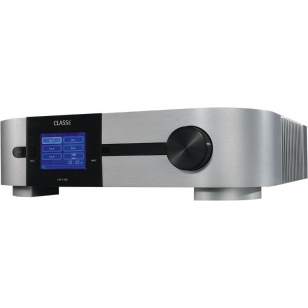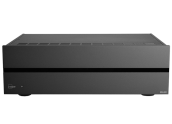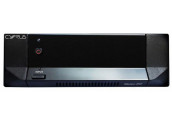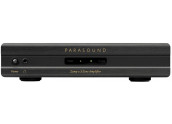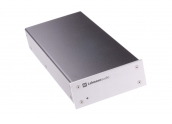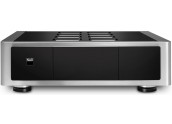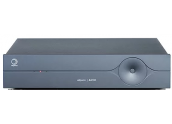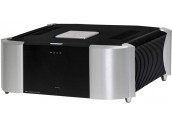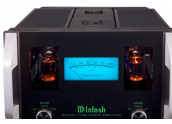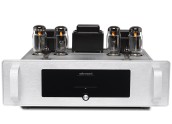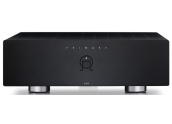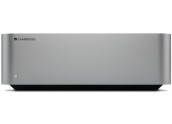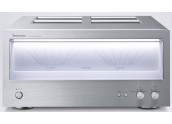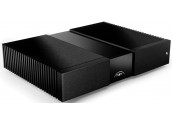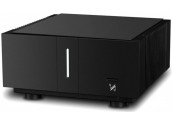Classe CP-500
The CP-500 is designed for two-channel music systems where superior musical performance and flexibility are required. The two primary preamplifier functions, source selection and volume control, are accomplished by executing fundamental design principles with premium parts. The Classé Design Team have developed the CP-500 to yield exceptional subjective performance while also achieving excellent measurements in the laboratory. It is the pursuit of both technical and musical virtue that inspire the CP-500 preamplifier. Advanced Mechanical Platform Most people incorrectly assume that vibration is only a concern for mechanical audio devices, such as disc players. The truth is that all audio components suffer loss in performance while subjected to external vibration and shock. This has been known to be a huge problem for vacuum tube devices (tap the top cover on a tube preamp and listen for sound coming through the speakers), but even solid state circuitry will generate noise signals, called microphonic distortion, when set in relative motion. This problem must be addressed, since most stereo components are installed in the listening room where they are used. They are subject to the vibrations induced by the sound of the system itself. The Classé Design Team are aware of these issues and take measures to protect against this clarity-reducing form of distortion. As with other Classé models, the CP-500 chassis is made of both steel and aluminum. The front panel wrap is an aluminum extrusion with a broad radius on the front corners. The feet are specially designed with Navcom™ LimbSaver® material to reduce the effects of external vibration. As a mechanical system, the chassis provides a rigid, stable, low-vibration platform for the preamplifier circuitry. Stable and Quiet Power Source High-performance audio circuits depend on clean, stable power. The Classé Design Team have gone to great lengths to ensure the CP-500 circuitry always benefits from an ideal power source. A custom made, shielded, high-regulation toroidal transformer with dual secondary windings keeps power for left and right channels completely separated back through the transformer. There is no electrical connection between channels. In addition to inter-channel isolation, digital control circuits are electrically separated from the analog audio circuitry. In all, nine separate regulators are used to provide locally clean power and isolation for independent circuit blocks. Low noise rectifiers and low ESR bypass capacitors also play a crucial role in supplying fast, quiet and stable power. Motherboard and Layout The motherboard (main pc board) of the CP-500 is made of high-grade FR-4 glass-epoxy. It provides both mechanical and electrical (low dielectric constant) advantages over less expensive materials. Left and right channels are located well away from each other along the center line of the motherboard, with good space between to optimize stereo separation. Large ground planes support quiet and fast power reservoirs and signal path lengths are kept to a minimum, with thick (2oz.) and wide (.05” to .075”) radiused copper traces to enable ideal low impedance connections. In short, the audio paths are short, simple and ideally managed to achieve greater purity and consistency of sound. Balanced Circuitry The CP-500 signal path is balanced from input to output. Even single-ended (RCA) type signals are treated as if they were balanced, with common mode noise and distortion on the ground being rejected when the balanced outputs are connected to a differential amplifier, such as a Classé delta series amplifier. This method also allows single-ended signals to pass without additional single-ended-to-balanced converter stages in the signal path. Balanced circuits, also called differential, provide a means for rejecting noise and distortion whenever it appears identically on two different signals. For this reason, balanced components and interconnects are designed to handle two separate signals. One is an inverted or mirror image of the other. When applied to a differential amplifier, the signals are subtracted, one from the other. The result is that noise and distortion that are the same on both signals (common mode) get subtracted away. The signals that are opposites of one another would add to zero if they were being added together, but since they are being subtracted, they produce a larger, clean copy of the original. When well executed, balanced signal paths may significantly outperform the standard single-ended variety. Signal Path Components The CP-500 switches inputs with shielded relays. They use gold-plated silver contacts and are ideal for switching low-level audio signals. In addition to passing ultra-low current and low-voltage signals, these precision relays are rated to perform to their specifications for over 100 million cycles.Volume is controlled using a Burr Brown PGA 2310 stereo volume control for each channel. The use of this stereo part in each channel maximizes stereo separation while also allowing better common mode rejection than would be possible with individual volume control devices for the two signal halves. This special high voltage part (±16V) allows any source to be connected without attenuation in the preceding buffer stage. Buffers at the input and output isolate the volume control from the source and amplifiers respectively. The input buffer provides a constant impedance load for sources while the output buffer offers a constant source impedance to amplifiers. The result is consistently high performance at any volume with a wide range of sources and amplifiers. In total, only 4dB of gain is needed from the buffers and 2dB from the volume control. This additional gain is only used in rare circumstances when the volume control is operated above 90.0dB.The beauty of the CP-500 design lies in its simplicity. The Classé Design Team used their knowledge and experience to develop the most simple and elegant design. The outstanding performance of the preamp owes to their careful orchestration of mechanical and electrical systems and the human ear. While the CP-500 test bench performance is exceptional, it does not tell the whole story. The volume control, buffers, precision resistors and bypass capacitors were all chosen based on listening evaluations. As always at Classé, the human ear is the final arbiter of sound. Optional Phono The CP-500 may be fitted with optional Classé phono modules (CPM). Gain is selectable from the front panel to accommodate both low-output (MC) and high-output (MM) cartridges with 72dB and 42dB of gain respectively. The signal path benefits from clean, quiet power, supplied by local ultra-low-noise regulator amplifiers. The entire signal path, including RIAA equalization is performed in balanced mode, preserving one of the inherent benefits of phono cartridge outputs. The CPM uses discrete, low-noise output drivers and passive components are all high-grade polypropylene capacitors and 1% film-type resistors. Custom phono loading may be added to available sockets on the pc board. Installation by an authorized Classé dealer is recommended. Control Digital control circuitry in the CP-500 is executed on several isolated locations including the center of the motherboard, a daughter card near the AC input and on a separate board behind the front panel. Power is derived from a separate winding on the main transformer as well as an independent secondary transformer/power supply. In addition to the preamp operation controls, the CP-500 monitors line voltage, frequency, AC phase and ground condition as well as internal temperature. Full control is available from the bi-directional RS-232 port on the rear panel, as well as by IR remote. DC trigger outputs enhance the system automation available from the CP-500. Touchscreen The front panel controls are implemented by way of a TFT touchscreen display, which simplifies the user interface, reduces display-related noise and allows users the convenience of customization. Name input buttons as you like and disable those that are not in use to remove them from the main operation screen. The touchscreen makes the preamplifier easier to use and also adds to its aesthetic value, whether used alone or together with other Classé delta series components. The Classé CP-500 is an outstanding example of attention to detail, superior performance and value. It utilizes fully-balanced circuitry, implemented symmetrically to reject noise and distortion. Simple and elegant operation and control is via TFT touchscreen, RS-232 and IR remote. model CP-500 frequency response distortion (THD + noise) 20Hz - 20kHz ± 0.1dB 0.003% analog section single-ended input (max level) single-ended output (max level) balanced input (max level) balanced output (max level) S/N ratio channel separation 5V 10V 10Vrms 20Vrms 110dB (max level to noise .oor) >110dB inputs single-ended inputs (no./impedance) single-ended tape inputs (no./impedance) balanced inputs (no./impedance) 3pr RCA (incl. 1 pr w/phono option) / 100kΩ 1pr RCA / 100kΩ 2pr XLR / 200kΩ outputs single-ended balanced tape out 1pr RCA 1pr XLR 1pr RCA weights & measurements width depth height gross weight net weight 17.5” (445 mm) 16.5” (419 mm) (excluding connectors) 4.75” (121 mm) 33 lbs (15 kg) 26 lbs (12 kg)
16 productos de la misma categoría:
-
Lyngdorf Audio MXA-8400
Lyngdorf Audio MXA-8400 etapa de potencia de 8 canales | 8x 400W 4Ω (modo de 2 canal...
8.999 € -
Cyrus Stereo 200
Stereo 200 Etapa de potencia 2 x 203W | Detección impedancia de Altavoces, clase D ...
2.895 € -
ArtSound PRL-3002
ArtSound PRL-3002 etapa de potencia 2 canales | Clase D | Rack 1U | Potencia RMS 2x ...
699 € -
Parasound ZAMP V3
Zamp V3 - Etapa de potencia de 2 canales - 45 vatios por canal en 8 Ω / 60 vatios p...
1.099 € -
Lehmann Audio Black Cube Stamp
Etapa de potencia estéreo y tamaño mini, 2 x 20 Watios a 4 Ohmios. Altavoces recomen...
1.349 € -
ArtSound PRL-1202
ArtSound PRL-1202 etapa de potencia 2 canales | Potencia RMS: 2x 200W a 4Ω, 2x 120W ...
399 € -
NAD M23 V2
NAD M23 V2 - Etapa de potencia 2 x200 Watios RMS a 8 Ohmios | Puenteable a Mono ->...
4.499 € -
Elipson A2700
Elipson A2700 etapa de potencia estéreo | Potencia RMS: 400W a 8 Ohms, 700W a4 Ohms,...
2.990 € -
Moon 861 North Collection
Moon 861 North Collection - Etapa de potencia estéreo de referencia - 2x300 Watios
25.000 € -
McIntosh MC2301
McIntosh MC2301 etapa de potencia de válvulas monofónica | 300W a 8 Ohms | Entrada: ...
23.499 € -
Audio Research VT80 SE
VT80SE -- Línea. 2x 75W a 8 ohmios. Entradas RCA y XLR. Válvulas: 2x KT120, 2x 6H30....
14.490 € -
Primare A35.2
Primare A35.2 Etapa de Potencia | Entradas: 1x XLR, 1x RCA | Salida: 2x 200W 8 ohmi...
3.190 € -
Cambridge Audio Edge W
Cambridge Audio Edge W | Etapa de potencia 2x100 Watios 8 Ohmios y 2x200 Watios a 4 ...
3.599 € 2.699 € -
-
Naim NAP 350
Naim NAP 350 Etapa de potencia monofónica 1x 175 Watios | Entradas XLR y RCA (median...
7.499 € -
QUAD Artera Stereo Outlet
QUAD Artera Stereo Etapa de Potencia balanceada | 140W 8 ohm | Entradas 2 x XLR, RCA...
2.199 € 1.499 €

